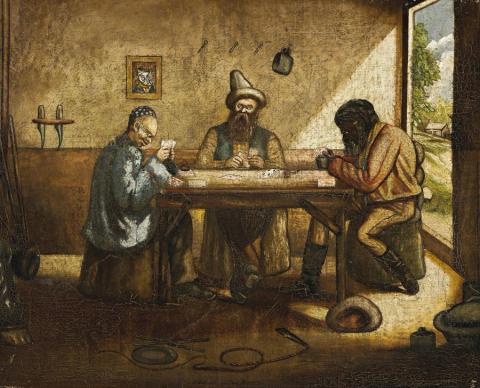EUCHRE IN THE BUSH, c.1870s
JOSEPH JOHNSON
oil on canvas on board
42.0 x 52.0 cm
inscribed lower centre: “EUCHRE IN THE BUSH”
Private collection, Melbourne
Euchre in the Bush, c1867, oil on canvas on board, 42.0 x 60.2 cm, collection of the Art Gallery of Ballarat, Victoria
Joseph Colin Francis Johnson was born in King William Street, Adelaide, in February 1848. In the early fifties he moved with his family to Victoria and was educated at the Geelong National Grammar School. Returning to South Australia in 1868, he joined the literary staff of The Register, winning favourable comment for his articles on mining and viticulture.
In 1880 he became proprietor and editor of Adelaide Punch, frequently contributing comic and satirical drawings during the several years that he conducted the paper. While holding this position, Johnson became prominently identified with gold mining and devoted his energies to promoting the mining interests of South Australia. He published many works on the subject including On the Wallaby, or Tales from the Men's Hut. In 1880 he rode to the Mount Browne Diggings and subsequently wrote accounts of his experiences in Moses and Me and To Mount Browne and Back. In London in 1895, he presented his collection of Australian nuggets to the British Museum, and a number of the most valuable and ornamental specimens to Queen Victoria who reciprocated with a large handsomely framed portrait of herself.
In 1884 he entered parliament as the member for Onkaparinga and in 1887 accepted the portfolio of Minister of Education, remaining in office for a period of two years. Johnson's name was prominently associated with the arts. As dramatic critic of The Register from 1875 to 1880, he took a deep interest in theatre and was involved in the Shakespearean revival in the Adelaide Theatre Royal. He was also known as a keen judge of pictures and his own black and white sketches were highly regarded. While on a European tour he purchased the painting Golden Autumn by Charles Stuart and presented it to the South Australian National Gallery.
